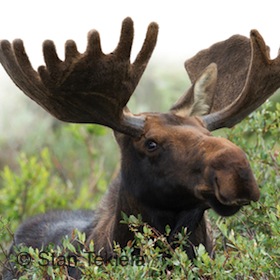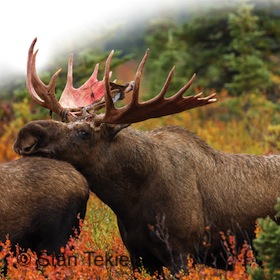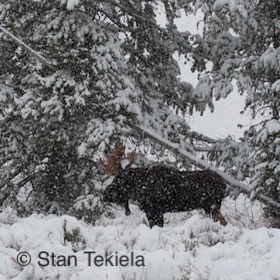Stan Tekiela Shares His Love for Moose
Naturalist and wildlife photographer Stan Tiekela shares with us his love for moose.
 Moose are magical—it’s just as simple as that! Their massive size and gentle nature endear them to those of us who seek them out and others who stop to admire them during a chance sighting. I have been studying and photographing moose for three decades and am constantly in awe of this amazing animal. With each encounter, I’m reminded that even though they are huge, they move with the grace and silence of a light breeze. It seems that everyone loves moose, and watching one during a vacation is often the highlight of the trip! Along with many people across the United States and Canada, I personally have great respect and admiration for this symbol of grandeur.
Moose are magical—it’s just as simple as that! Their massive size and gentle nature endear them to those of us who seek them out and others who stop to admire them during a chance sighting. I have been studying and photographing moose for three decades and am constantly in awe of this amazing animal. With each encounter, I’m reminded that even though they are huge, they move with the grace and silence of a light breeze. It seems that everyone loves moose, and watching one during a vacation is often the highlight of the trip! Along with many people across the United States and Canada, I personally have great respect and admiration for this symbol of grandeur.
When you see one, you just can’t help but stop to admire it. The largest and most magnificent member of the deer family, moose are closely related to caribou, deer, and elk. They are found all across the Northern Hemisphere, from China to Scandinavia and throughout northern North America. However, the common name “moose” is used only in North America. In Europe, moose are known as elk. This can be confusing for people in the United States and Canada because we have a different animal that goes by that name. But regardless—you’ll never mistake a moose for an elk.
 Where moose live, the lakes freeze in winter and a thick blanket of snow covers the landscape. Winter is a good time of year for moose. While smaller animals seek shelter to buffer against the cold and birds struggle to find food, moose thrive. They’ve grown a thick fur coat of long, hollow hairs that insulates them from extremely bitter temperatures and keeps them warm. Their large body mass also helps them retain body heat very efficiently. Not only that, their long legs get them through even the deepest snow, and they meander around to find food and water.
Where moose live, the lakes freeze in winter and a thick blanket of snow covers the landscape. Winter is a good time of year for moose. While smaller animals seek shelter to buffer against the cold and birds struggle to find food, moose thrive. They’ve grown a thick fur coat of long, hollow hairs that insulates them from extremely bitter temperatures and keeps them warm. Their large body mass also helps them retain body heat very efficiently. Not only that, their long legs get them through even the deepest snow, and they meander around to find food and water.
Good to Know
Adult animals need to consume about 45 pounds of food daily. They feed on the most abundant and nutritious plants available, such as fresh green plants, woody twigs, moss, and lichens. Aspen, willow, birch, and alder leaves are their prime foods, but they also eat tree bark. Moose browse trees and shrubs by grasping twigs and small branches with their lips. They lack upper incisors but bite effectively with their flat, bony upper palate and sharp lower incisors. Jerking their heads back, they rip off an entire twig, leaving a ragged stump. Moving from one feeding area to another, they alternate between feeding and resting about 7–10 times per day.
 Moose enjoy different diets in each season. In spring, they concentrate mainly on sodium-rich aquatic plants.
Moose enjoy different diets in each season. In spring, they concentrate mainly on sodium-rich aquatic plants.
A moose dips its head underwater to grab a mouthful of lush greens. Lifting its head slowly, it munches and swallows as water drips all around. Many moose never submerge their heads deep enough to get their ears wet. Others dive 20 feet down to gather plants from the pond bottom.
During early summer, moose switch their diet and start to feed upon maturing, nutritious, terrestrial green plants, including grasses, sedges, and forbs (flowering plants). Others eat these foods in late summer. In autumn, the bulls eat far less than usual, as their appetites are suppressed during the breeding season.
Moose have the ability to survive on just a meager supply of twigs during winter, with woody twigs from shrubs making up the main part of their diet. The way they eat these foods relates to how the common name “moose” came about. The Algonquian Indian name moos means “he strips off” and refers to how moose get leaves, twigs, and bark off plants and trees when feeding.
If you enjoyed this post, you may consider one of Stan Tekiela’s amazing nature books: Majestic Eagles; The Lives of Wolves, Coyotes, and Foxes; or Backyard Birds: Welcomed Guests at our Gardens and Feeders. Young readers will delight in his award-winning children’s books, such as Whose Butt?, Critter Litter, and his latest, Jump, Little Wood Ducks.
You can follow Stan on Facebook and Twitter, or contact him via his web page. Stan’s nationally syndicated NatureSmart Column appears in more than 25 cities spanning 5 states (Minnesota, Wisconsin, Michigan, Illinois, and Pennsylvania) and is circulated to more than 750,000 readers. Stan’s author page on Amazon features some amazing videos! Check them out, and follow him for updates.
For more stories about wildlife and nature, sign up for our newsletter now!
You may also enjoy these posts:
Indigo Bunting—A Familiar Summer Visitor
The Nesting Behaviors of Sandhill Cranes
Big Birds, Baby Birds, Birds Everywhere
Stan Tekiela observes Marsh Wrens
The Magical, Mystical World of Sandhill Cranes


